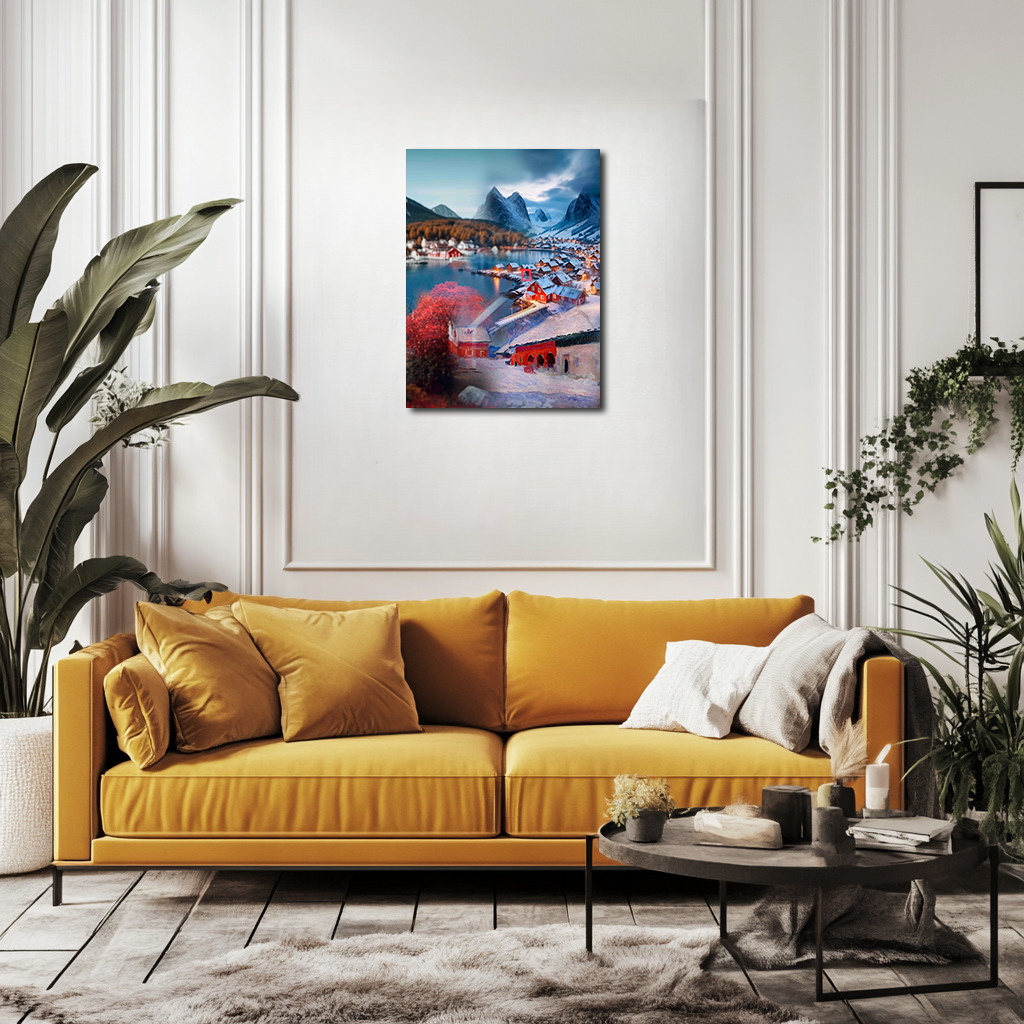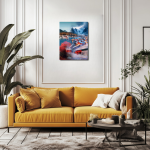Light Between Mountains: The Red Houses of Bjornegaard Remembered in Winter
Light Between Mountains: The Red Houses of Bjornegaard Remembered in Winter reimagines Monet’s 1895 painting as a layered dreamscape of snow, memory, and warmth. Crimson houses glow like lanterns amid frozen stillness, watched over by towering blue mountains and framed by the glow of an autumn forest. This conceptual landscape explores belonging, season, and the quiet endurance of light within cold.
Please see Below for Details…
Hotline Order:
Mon - Fri: 07AM - 06PM
404-872-4663
Claude Monet’s Red Houses at Bjornegaard in the Snow , painted during his 1895 journey through Norway, remains one of the most striking testaments to his exploration of light in extreme conditions. There, amid snow-laden slopes and crimson cottages, Monet studied not only the reflection of the sun against white surfaces, but the emotional hush of winter’s embrace. In this conceptual reinterpretation, titled Light Between Mountains: The Red Houses of Bjornegaard Remembered in Winter , the original landscape dissolves into a layered meditation on warmth in isolation, time suspended by cold, and the quiet geometry of belonging.
The composition unfolds in soft veils of memory and season. Snow lies across rooftops and mountains like folded linen, undisturbed, luminous, quiet. The village of red houses—clustered in orderly warmth along the edge of a frozen inlet—glows from within, each window flickering like a held breath in the blue hush of evening. These homes do not simply exist—they radiate. Each one is a lantern in the frozen dark, each one a story told through fire and shelter, through shape and silhouette.
The mountains in the distance rise with impossible grace—jagged, luminous, and serene. Their slopes are velvet with snow, their peaks brushed with the last blue of day. They are not threatening. They are present. Guardians. Watchers. Sculptures of stillness that frame the village below like cathedral columns. This space, nestled between mountain and ice, becomes a cradle for memory, a container for color, and a threshold between time and season.
What begins as a landscape grows more surreal as the eye moves leftward. There, a glowing forest of rust-colored trees interrupts the quiet. These trees do not belong to the snow—they seem imported from another memory, autumnal in hue and bursting with saturated warmth. A beam of light falls diagonally from above, cutting across the foreground and landing on a singular red house, catching its roof in a quiet exhale of brilliance. The contrast of warm red against the snow-white earth speaks to a deeper question—what do we carry into winter that keeps us from freezing inward.
The composition is not linear. It is layered. Below the village, along the edge of the scene, another red building emerges. This one is textured more like pigment, less like photograph. Its form is painterly, as if Monet’s brush were still at work underneath the layers of digital reinterpretation. This layering creates a dialogue—not just of visual form, but of memory itself. The image becomes a palimpsest, where one season overlays another, one light overwrites another, but nothing is ever fully erased.
Color holds the emotional current of this piece. The deep reds of the houses and trees create a pulse amid the cool blues and whites. These reds are not loud. They are ancient. They carry the warmth of history, of hearths burning through snow, of lives lived close to the earth. The whites are not empty. They are heavy with silence, soft with reflection. They are not erasure—they are embrace.
The water in the center glows with subtle blues, catching reflections of gold and crimson light, its surface partly frozen, partly dream. It does not dominate the scene. It gathers it. It acts as mirror and membrane, holding the surrounding forms like a memory held just below the surface of thought. The bridges across it—simple and wooden—do not just connect land. They connect time.
As the artist, I approached this reinterpretation as a meditation on enclosure and illumination. In Norway, Monet painted not just landscapes, but the experience of being small within light. Here, the red houses are less about structure and more about flame. They glow against the cold, not in defiance, but in harmony. The snow is not the enemy. It is the quiet witness.
Light Between Mountains is not simply a winter village. It is a landscape of inner warmth held within outer stillness. It is the memory of color pressed into white, the hum of life inside a frozen hour. The mountains rise like thought, the forest glows like desire, and the red houses remain—firm, burning, and seen.
Add your review
Your email address will not be published. Required fields are marked *
Please login to write review!
Looks like there are no reviews yet.








